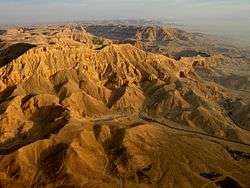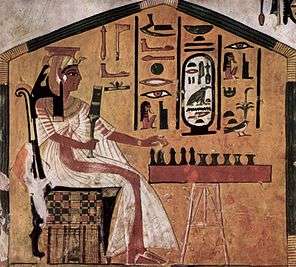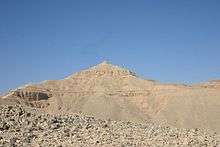Valley of the Queens
Coordinates: 25°43′39″N 32°35′35″E / 25.72750°N 32.59306°E
| Valley of the Queens in hieroglyphs | ||||||||
|---|---|---|---|---|---|---|---|---|
|
Ta-set-neferu T3-st-nfrw The place of beauty | ||||||||
 | ||||||||
The Valley of the Queens (Arabic: وادي الملكات Wādī al Malekāt) is a site in Egypt, where wives of Pharaohs were buried in ancient times. In ancient times, it was known as Ta-Set-Neferu, meaning –"the place of beauty".
Using the limits as described by Christian Leblanc, the Valley of the Queens consists of the main wadi which contains most of the tombs, as well as the Valley of Prince Ahmose, the Valley of the Rope, the Valley of the Three Pits, and the Valley of the Dolmen. The main wadi contains 91 tombs and the subsidiary valleys add another 19 tombs. The burials in the subsidiary valleys all date to the 18th dynasty.[1]
The reason for choosing the Valley of the Queens as a burial site is not known. The location in close proximity to the worker's village in Deir el-Medina and the Valley of the Kings may have been a factor. Another consideration may be the existence of a sacred grotto dedicated to Hathor at the entrance of the Valley. This grotto may be associated with rejuvenation for the dead.[1]
Eighteenth Dynasty
One of the first tombs to be made in the Valley of the Queens is the tomb of Princess Ahmose, a daughter of Seqenenre Tao and Queen Sitdjehuti. This tomb likely dates to the reign of Thutmose I. The tomb from this period also include several members of the nobility, including a head of the stables and a Vizier.[1]
The tombs from the Valley of the Three Pits mostly date to the Thutmosid period. The tombs are labeled with letters A - L. The valley also contains three shaft tombs for which the valley was given its name. The modern labels for these three tombs are QV 89, QV 90, and QV 91.[1]
The Valley of the Dolmen contains an old trail used by the workmen traveling from Deir el-Medina to the Valley of the Queens. Along this path is a small rock-cut temple dedicated to Ptah and Meretseger.[1]
The tombs from this time period are generally simple in form and consist of a chamber and a shaft for burial. Some of the tomb were extended in size to accommodate more than one burial. The tombs include those of several royal princes and princesses, as well as some nobles.[1]
A tomb of the Princesses was located in the Valley. This tomb dates to the time of Amenhotep III. The present location is unknown, but finds from the tomb are in museums and include fragments of burial equipments for several members of the royal family.[2] Some finds include a canopic jar fragment of the King's Wife Henut. She is thought to have lived mid 18th Dynasty. Her name was enclosed in a cartouche. Canopic jar fragments mentioning Prince Menkheperre, a son of Tuthmosis III and Merytre Hatshepsut was found. A King's Great Wife Nebetnehat from the mid 18th Dynasty is attested because her name was enclosed in a cartouche on canonic fragments. Canopic jar fragments with the name of the King's Daughter Ti from the mid 18th Dynasty were found as well.[3]
Nineteenth Dynasty

During the 19th dynasty the use of the Valley becomes more exclusive. The tombs from this period exclusively belong to royal women. Many of the high-ranking wives of Ramesses I, Seti I and Ramesses II were buried in the Valley. One of the most well-known examples is the resting place carved out of the rock for Queen Nefertari (1290–1224 BCE). The polychrome reliefs in her tomb are still intact. Other members of the royal family continue to be buried in the Valley of the Kings. Tomb KV5, the tomb of the sons of Ramesses II is an example of this practice.[1]
The tomb of Queen Satre (QV 38) is likely the first tomb prepared during this dynasty. It was likely started during the reign of Ramesses I and finished during the reign of Seti I. Several tombs were prepared without an owner in mind, and the names were included upon the death of the royal female.[1]
Twentieth Dynasty
During the beginning of 20th dynasty the Valley was still used extensively. Tombs for the wives of Ramesses III were prepared, and in a departure from the conventions of the previous dynasty, several tombs were prepared for royal sons as well. The creation of tomb continues at least until the reign of Ramesses VI. The Turin Papyrus mentions the creation of six tombs during the reign of Ramesses VI. It is not known which tombs are referred to in that papyrus.[1]
There is evidence of economic turmoil during the 20th dynasty. Records show that the workers went on a strike during the reign of Ramesses III. And towards the end of the dynasty there are reports of tomb robberies.[1]
Third Intermediate Period and later
The Valley was no longer a royal burial site after the close of the 20th dynasty. Many of the tombs were extensively reused. Several tombs were adjusted so that they would hold multiple burials. In some cases this involved digging burial pits in the existing tombs. Not much is known about the use of the Valley of the Queens during the Ptolemaic Period. During the Roman Period however we see a renewed extensive use of the Valley as a burial site. During the Coptic Period some Hermit shelters were erected. Tombs QV60 (Nebettawy) and QV73 (Henuttawy) show signs of Coptic occupation. Wall scenes were covered with plaster and decorated with Christian symbols. The Christian presence lasted until the 7th Century.[1]
Principal burials
| Tomb | Name of tomb owner | Status | Time Period | Comments |
|---|---|---|---|---|
| QV8 | Hori and a King's Daughter | Prince / Princess | 18th dynasty | |
| QV17 | Merytre and Wermeryotes | Princesses | 18th dynasty | |
| QV30[3] | Nebiri | Head of the Stables | 18th dynasty | Reign of Tuthmosis III[1] |
| QV31[3] | Anonymous | Queen | 19th dynasty | Time of Seti I[1] |
| QV33[3] | Tanedjemet | Princess-Queen | 19th dynasty | Time of Sety I[1] |
| QV34 | Anonymous | Princess-Queen | 19th dynasty | Time of Seti I[1] |
| QV36[3] | Anonymous | Princess-Queen | 19th dynasty | Time of Seti I[1] |
| QV38[3] | Sitre | Queen | 19th dynasty | wife of Ramesses I[1] |
| QV40[3] | Anonymous | Princess-Queen | 19th dynasty | Time of Seti I[1] |
| QV42[3] | Pareherwenemef | Prince | 20th dynasty | son of Ramesses III, Possibly also occupied by Minefer, wife of Rameses III [1] |
| QV43[3] | Seth-her-khopsef (Ramesses VIII) | Prince | 20th dynasty | son of Ramesses III, took the throne as Ramesses VIII, Tomb was unused. |
| QV44[3] | Khaemwaset | Prince | 20th dynasty | son of Ramesses III, Buried in reign of Rameses IV[1] |
| QV46[3] | Imhotep | Vizier | 18th dynasty | vizier under Thutmose I |
| QV47[3] | Ahmose | Princess | 17th dynasty | daughter of Tao II the Brave and Sitdjehuti |
| QV51[3] | Iset Ta-Hemdjert | Queen | 20th dynasty | wife of Ramesses III, mother of Ramesses VI |
| QV52[3] | Tyti | Princess-Queen | 20th dynasty | Wife of Ramesses III, daughter of Setnakhte |
| QV53[3] | Ramesses Meryamen (Ramesses IV) | Prince | 20th dynasty | son of Ramesses III, took the throne as Ramesses IV, Tomb was unused, buried in KV2 |
| QV55[3] | Amun-her-khepeshef | Prince | 20th dynasty | son of Ramesses III |
| QV58 | Anonymous | Queen | 19th dynasty | Time of Ramesses II[1] |
| QV60[3] | Nebettawy | Princess-Queen | 19th dynasty | daughter-wife of Ramesses II |
| QV66[3] | Nefertari | Queen | 19th dynasty | wife of Ramesses II |
| QV68[3] | Meritamun | Princess-Queen | 19th dynasty | daughter-wife of Ramesses II |
| QV70 | Nehesy | 18th dynasty[1] | ||
| QV71[3] | Bintanath | Princess-Queen | 19th dynasty | daughter-wife of Ramesses II |
| QV72 | Neferhat / Baki | Princess and Prince | 18th dynasty | |
| QV73[3] | Henuttawy | Princess-Queen | 19th dynasty | daughter-wife of Ramesses II[1] |
| QV74[3] | (Dua)Tentopet | Queen | 20th dynasty | wife of Ramesses IV. Usurped from an unused tomb of a 19th dynasty Princess.[1] |
| QV75[3] | Henutmire | Princess-Queen | 19th dynasty | daughter-wife of Ramesses II (or possibly a sister) |
| QV76 | Merytre | Princess | 18th dynasty[1] | |
| QV80 | Queen (Mut-)Tuy | Queen | 19th dynasty | wife of Seti I and mother of Ramesses II.[3] |
| QV81 | Heka[...] | 18th dynasty | Name only partially preserved[1] | |
| QV82 | Minemhat and Amenhotep | Princes | 18th dynasty[1] | |
| QV88 | Ahmose | Prince | 18th dynasty[1] | Son of Nebesu and Ian. The mummy was that of a fetus.[1] |
References
- 1 2 3 4 5 6 7 8 9 10 11 12 13 14 15 16 17 18 19 20 21 22 23 24 25 26 27 28 29 Demas, Martha, and Neville Agnew, eds. 2012. Valley of the Queens Assessment Report: Volume 1. Los Angeles, CA: Getty Conservation Institute. Getty Conservation Institute, link to article
- ↑ Dodson A. and Hilton D. The Complete Royal Families of Ancient Egypt, London 2004
- 1 2 3 4 5 6 7 8 9 10 11 12 13 14 15 16 17 18 19 20 21 22 23 24 Porter, Bertha and Moss, Rosalind, Topographical Bibliography of Ancient Egyptian Hieroglyphic Texts, Statues, Reliefs and Paintings Volume I: The Theban Necropolis, Part 2. Royal Tombs and Smaller Cemeteries, Griffith Institute. 1964, pg 766-7
Sources
- Bunson, Margaret (1991). "Valley of the Queens". Encyclopædia of Ancient Egypt. New York.
External links
| Wikimedia Commons has media related to Valley of the Queens. |
- "Tour Egypt: Valley of the Queens in Thebes, Egypt". Retrieved 27 March 2013.
- "Luxor: Valley of the Queens". Retrieved 27 March 2013.
- "Getty Conservation Institute: Valley of the Queens". Retrieved 27 March 2013.


